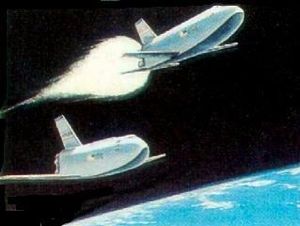
Home - Search - Browse - Alphabetic Index: 0- 1- 2- 3- 4- 5- 6- 7- 8- 9
A- B- C- D- E- F- G- H- I- J- K- L- M- N- O- P- Q- R- S- T- U- V- W- X- Y- Z
Shuttle DC-3
 Shuttle NAR A DC-3 booster / orbiter stage separation at 70km altitude. Credit: NASA |
Status: Study 1970. Payload: 5,700 kg (12,500 lb). Thrust: 11,433.20 kN (2,570,286 lbf). Gross mass: 998,775 kg (2,201,921 lb). Height: 74.00 m (242.00 ft). Diameter: 5.08 m (16.66 ft). Apogee: 500 km (310 mi).
Payload for the Faget vehicle was to be only 5,700 to 6,800 kg to low earth orbit, and the system was to be operational by the end of 1975, after the last Apollo flight.
MSC-001 was the first in a long series of Faget straight-wing designs. It featured an 2.4 m x 9.1 m payload bay, and a cross-range of just 300 km. The orbiter was equipped with two booster engines (XLR-129 modifications with 134,700 kgf), 2 orbital maneuvering engines (RL10's with 6800 kgf), and six air-breathing engines (RB162-86's of 2,400 kgf burning JP-4 jet fuel). The booster would be equipped with booster engines, and Pratt and Whitney TF-B turbofan engines of 8,100 kgf for flyback. The launch scenario was for the booster to take the orbiter to altitude, release it, and then land at a down-range airfield. It would be refueled there with jet fuel and fly back on its turbofan engines to the launch site. The orbiter had a 27.7 m wingspan with a 14 deg wing leading-edge sweep. The aluminum structure was protected by a silica-based thermal protection system. The booster would be 61.9 m long, have a 43 m wingspan with the same 14 degree sweep, and a total wing area of 264 square m. The leading edge would be protected by a pyrolized carbon laminate, and the lower surface by a silica-based thermal protection system. The payload would be delivered into a 500 km orbit at a 51 deg inclination. It was expected a fleet of six orbiters and four boosters would undertake 30 flights per year, each spacecraft having a life of 100 flights. It was expected a 48-hour reaction time between order for launch and launch would be possible. Total development cost of the orbiter was estimated as $2.77 billion, with the first article costing $171.2 million. The booster would cost $3.142 billion to develop, with a first article cost of $236 million.
LEO Payload: 5,700 kg (12,500 lb) to a 500 km orbit at 28.00 degrees. Flyaway Unit Cost 1985$: 38.000 million.
Stage Data - Shuttle DC-3
- Stage 1. 1 x Shuttle DC-3-1. Gross Mass: 799,537 kg (1,762,677 lb). Empty Mass: 131,519 kg (289,949 lb). Thrust (vac): 10,290.000 kN (2,313,280 lbf). Isp: 442 sec. Burn time: 277 sec. Isp(sl): 392 sec. Diameter: 5.08 m (16.66 ft). Span: 42.99 m (141.04 ft). Length: 61.89 m (203.05 ft). Propellants: Lox/LH2. No Engines: 4. Engine: SSME Study. Status: Study 1970 April. Comments: Faget Configuration.
- Stage 2. 1 x Shuttle DC-3-2. Gross Mass: 199,238 kg (439,244 lb). Empty Mass: 54,422 kg (119,979 lb). Thrust (vac): 2,940.000 kN (660,930 lbf). Isp: 459 sec. Burn time: 218 sec. Isp(sl): 359 sec. Diameter: 4.45 m (14.59 ft). Span: 27.68 m (90.81 ft). Length: 37.40 m (122.70 ft). Propellants: Lox/LH2. No Engines: 1. Engine: SSME Study. Status: Study 1970 April. Comments: Faget Configuration - Cross Range 323 km.
Family: orbital launch vehicle, Winged. Country: USA. Engines: SSME Study. Stages: Shuttle DC-3-1, Shuttle DC-3-2. Agency: NASA.
Back to top of page
Home - Search - Browse - Alphabetic Index: 0- 1- 2- 3- 4- 5- 6- 7- 8- 9
A- B- C- D- E- F- G- H- I- J- K- L- M- N- O- P- Q- R- S- T- U- V- W- X- Y- Z
© 1997-2019 Mark Wade - Contact
© / Conditions for Use